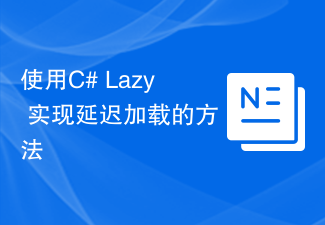 Java
Java javaTutorial
javaTutorial The Art of Concurrency: Master Java Concurrency Collections and Make Your Code Fly
The Art of Concurrency: Master Java Concurrency Collections and Make Your Code Fly
php editor Baicao discovered that mastering Java concurrent collections will make your code fly! Java concurrent collections are an important part of Java programming, which provide methods to safely operate data structures in a multi-threaded environment. By learning and mastering Java concurrent collections, you can handle various problems in concurrent programming more efficiently and improve program performance and reliability. Let's delve into Java concurrent collections together, discover the secrets and techniques, and help you become a better Java programmer!
- ConcurrentHashMap: A threaded safe hash table that can efficiently store and retrieve key-value pairs.
- ConcurrentLinkedQueue: A thread-safe bidirectional queue that supports first-in, first-out (FIFO) operations.
- CopyOnWriteArrayList: A thread-safe list that only allows copy-on-write, which will not cause concurrency modification problems when traversing.
- BlockingQueue: A queue that supports blocking operations. When the queue is empty, the thread will block until an element is available.
Advantages of using concurrent collections
- Data consistency: ConcurrencyCollection Provides synchronous access to shared data to prevent thread conflicts and data corruption.
- Performance optimization: Concurrent collections have been optimized and can efficiently handle concurrent operations in a multi-threaded environment.
- Simplify development: Using concurrent collections can simplify multi-threaded programming, without the need to manually implement the synchronization mechanism.
Notes on using concurrent collections
- Deadlock: When using concurrent collections, you need to be careful to avoid deadlocklock, that is, two or more threads wait for each other to release the lock.
- Performance overhead: The synchronization mechanism of concurrent collections will bring certain performance overhead and should not be used when concurrent operations are not required.
- Choose the appropriate collection: Choose the appropriate concurrent collection according to specific needs. Different collections have different characteristics and applicable scenarios.
Best Practices
- Use lock-free collections: If possible, try to use lock-free concurrent collections, such as ConcurrentHashMap, they can provide better performance.
- Limit concurrent access: Restrict concurrent access to shared data through locks or atomic operations to avoid excessive competition.
- Use copies: When you need to modify shared data frequently, you can consider using copies instead of directly modifying the original data.
- Monitor concurrent behavior: Use tools or log record Monitor concurrent behavior to discover potential problems in a timely manner.
Mastering the skills of concurrent collections
- Understand the implementation of concurrent collections: Be familiar with the internal mechanism of concurrent collections and understand the synchronization mechanism and data structure they provide.
- Master the basics of concurrent programming: Be familiar with Concurrent programming concepts, such as thread safety, locks and atomic operations.
- Practical exercises: Practice and deepen your understanding by writing multi-threaded programs and using concurrent collections.
- Reference documentation and tutorials: Check the official documentation and tutorials to learn the detailed usage and best practices of concurrent collections.
The above is the detailed content of The Art of Concurrency: Master Java Concurrency Collections and Make Your Code Fly. For more information, please follow other related articles on the PHP Chinese website!
 C#开发中如何处理线程同步和并发访问问题Oct 08, 2023 pm 12:16 PM
C#开发中如何处理线程同步和并发访问问题Oct 08, 2023 pm 12:16 PMC#开发中如何处理线程同步和并发访问问题,需要具体代码示例在C#开发中,线程同步和并发访问问题是一个常见的挑战。由于多个线程可以同时访问和操作共享数据,可能会出现竞态条件和数据不一致的问题。为了解决这些问题,我们可以使用各种同步机制和并发控制方法来确保线程之间的正确协作和数据一致性。互斥锁(Mutex)互斥锁是一种最基本的同步机制,用于保护共享资源。在需要访
 Linux环境编程必须搞懂的几个概念Feb 15, 2024 am 08:03 AM
Linux环境编程必须搞懂的几个概念Feb 15, 2024 am 08:03 AM对于初学者来说,要想在Linux环境下编程,必须深入理解一些重要概念才能更好地编写代码,实现业务功能。下面我们将介绍几个重要且常用的知识点。掌握这些概念可以避免在将来的编码中出现混淆。系统调用“❝所有操作系统的内核中都有一些内置函数,这些函数可以用来完成一些系统级别的功能。在Linux系统中,这些函数被称为“系统调用”(systemcall)。它们代表了从用户空间到内核空间的一种转换。❞”已收到消息.对于初学者来说,要想在Linux环境下编程,必须深入理解一些重要概念才能更好地编写代码,实现业务
 使用C# Lazy 实现延迟加载的方法Feb 19, 2024 am 09:42 AM
使用C# Lazy 实现延迟加载的方法Feb 19, 2024 am 09:42 AMC#如何使用Lazy实现懒加载,需要具体代码示例在软件开发中,懒加载(Lazyloading)是一种延迟加载的技术,它可以帮助我们提高程序的性能和资源利用效率。在C#中,我们可以使用Lazy类来实现懒加载的功能。本文将介绍Lazy类的基本概念以及如何使用它来实现懒加载,同时会提供具体的代码示例。首先,我们需要了解Lazy
 Java EJB架构详解,构建稳定可扩展的系统Feb 21, 2024 pm 01:13 PM
Java EJB架构详解,构建稳定可扩展的系统Feb 21, 2024 pm 01:13 PM什么是EJB?EJB是一种Java平台企业版(JavaEE)规范,定义了一组用于构建服务器端企业级Java应用程序的组件。EJB组件封装了业务逻辑,并提供了一组用于处理事务、并发、安全性和其他企业级关注点的服务。EJB体系结构EJB体系结构包括以下主要组件:企业Bean:这是EJB组件的基本构建块,它封装了业务逻辑和相关的数据。EnterpriseBean可以是无状态的(也称为会话bean)或有状态的(也称为实体bean)。会话上下文:会话上下文提供有关当前客户端交互的信息,例如会话ID和客户端
 PHP和SQLite:如何处理并发访问和锁定问题Jul 29, 2023 am 10:05 AM
PHP和SQLite:如何处理并发访问和锁定问题Jul 29, 2023 am 10:05 AMPHP和SQLite:如何处理并发访问和锁定问题引言:在现代的Web开发中,数据库通常被用来存储和管理数据。SQLite是一种轻量级的数据库引擎,被广泛应用于PHP开发中。然而,在高并发的环境中,如何处理多个同时访问数据库的请求,以及如何避免数据竞争等问题成为了一个关键的挑战。本文将介绍如何使用PHP和SQLite来处理并发访问和锁定问题,并提供相应的代码示
 C#开发中如何处理线程同步和并发访问问题及解决方法Oct 08, 2023 am 09:55 AM
C#开发中如何处理线程同步和并发访问问题及解决方法Oct 08, 2023 am 09:55 AMC#开发中如何处理线程同步和并发访问问题及解决方法随着计算机系统和处理器的发展,多核处理器的普及使得并行计算和多线程编程变得非常重要。在C#开发中,线程同步和并发访问问题是我们经常面临的挑战。没有正确处理这些问题,可能会导致数据竞争(DataRace)、死锁(Deadlock)和资源争用(ResourceContention)等严重后果。因此,本篇文章将
 Golang 加密/兰德线程安全吗?Feb 09, 2024 pm 12:45 PM
Golang 加密/兰德线程安全吗?Feb 09, 2024 pm 12:45 PMmath/rand.rand的源指出read不是线程安全的(共享源时)。加密/兰特怎么样?源代码指出它使用getrandom(2)或/dev/urandom,但尚不清楚并发调用会发生什么。更新:评论有助于澄清区别crypto/rand.Reader.Read(b[]byte)crypto/rand.Read(b[]byte)线程安全:并发调用read会panic吗?并发调用时会保持随机序列吗?或者可以向并发调用者提供重复的内容吗?
 Golang多线程编程的最佳实践指南Feb 29, 2024 pm 01:42 PM
Golang多线程编程的最佳实践指南Feb 29, 2024 pm 01:42 PMGolang多线程编程的最佳实践指南Go语言(Golang)是一种快速、简单且强大的编程语言,具有优秀的并发编程能力。通过支持原生的goroutine和channel,Golang为开发者提供了一种简单而高效的方式来进行多线程编程。本文将介绍Golang多线程编程的最佳实践,包括如何创建和管理goroutines,如何使用channel进行线程间通信,以及如


Hot AI Tools

Undresser.AI Undress
AI-powered app for creating realistic nude photos

AI Clothes Remover
Online AI tool for removing clothes from photos.

Undress AI Tool
Undress images for free

Clothoff.io
AI clothes remover

AI Hentai Generator
Generate AI Hentai for free.

Hot Article

Hot Tools

EditPlus Chinese cracked version
Small size, syntax highlighting, does not support code prompt function

ZendStudio 13.5.1 Mac
Powerful PHP integrated development environment

Safe Exam Browser
Safe Exam Browser is a secure browser environment for taking online exams securely. This software turns any computer into a secure workstation. It controls access to any utility and prevents students from using unauthorized resources.

Dreamweaver Mac version
Visual web development tools

VSCode Windows 64-bit Download
A free and powerful IDE editor launched by Microsoft





